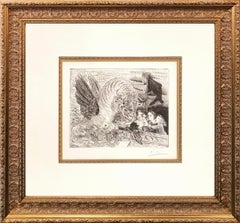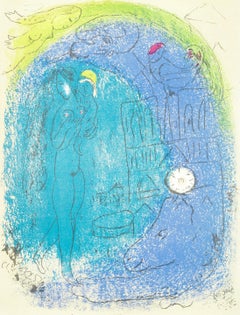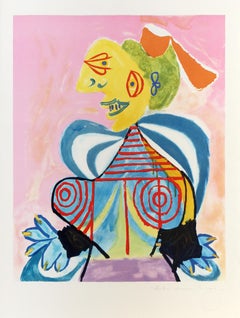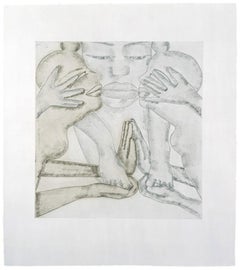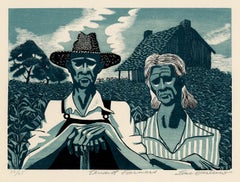Face Figurative Prints
to
2,006
4,189
1,358
1,326
554
339
Overall Width
to
Overall Height
to
2,689
1,269
464
426
376
304
233
144
102
73
59
18
5
2
300
139
101
85
67
515
1,062
5,107
1,100
73
128
413
305
292
506
578
926
576
221
456
5,810
1,717
227
26,952
14,778
10,577
9,088
7,784
7,002
4,600
4,164
2,410
2,041
1,929
1,867
1,659
1,472
1,460
1,447
1,431
1,297
1,227
1,106
3,234
2,131
1,038
541
516
832
3,484
3,347
3,145
Art Subject: Face
TAUREAU AILE CONTEMPLE PAR QUATRE ENFANTS (BLOCH 229)
Located in Aventura, FL
Plate 13 from La Suite Vollard. Bloch 229. Baer 444. Etching on Montval paper. Signed in pencil, from the edition of 260 (there was also an edition of 50 with larger margins). Printe...
Category
1930s Cubist Animal Prints
Materials
Paper, Engraving
$31,600 Sale Price
29% Off
Marc Chagall, Mother and Child before Notre-Dame, Verve, Revue Artistique, 1953
By Marc Chagall
Located in Southampton, NY
This exquisite lithograph by Marc Chagall (1887–1985), titled Mere et enfant devant a Notre-Dame (Mother and Child before Notre-Dame), from Verve, Revue Artistique et Litteraire, Vol...
Category
1950s Expressionist Landscape Prints
Materials
Lithograph
"Untitled"
Located in Southampton, NY
Original artist proof engraving, aquatint, intaglio on archival paper by the Russian/American artist, Nahum Tschacbasov. Signed in pencil lower right and dated 1947. Condition: good...
Category
1940s Surrealist Figurative Prints
Materials
Archival Paper, Engraving, Aquatint, Intaglio
$420 Sale Price
20% Off
L'Arlesienne, Cubist Lithograph after Pablo Picasso
Located in Long Island City, NY
Pablo Picasso's depiction of a woman from Alès is bright and colorful, rendered in bright shades of pink, yellow, and blue. Shown in a Cubist style with her face and body fragmented,...
Category
Late 20th Century Cubist Portrait Prints
Materials
Lithograph
Francesco Clemente, Geography, North
Located in New York, NY
NORTH
Year: 1992
Medium: 2-color, soft ground etching
Paper Size: 28 x 25 inches (71 x 64 cm)
Plate Size: 19 x 18 inches (48 x 46 cm)
Edition: 60
Price: $6,000
Suite of four also a...
Category
1990s Contemporary Figurative Prints
Materials
Etching
'Tenant Farmers' — Depression Era, WPA
By Lou Barlow
Located in Myrtle Beach, SC
Lou Barlow (Louis Breslow), 'Tenant Farmers', color wood engraving, 1936, edition 25. Signed, titled, and numbered '15/25' in pencil. A superb, richly-inked impression, with fresh c...
Category
1930s American Modern Figurative Prints
Materials
Woodcut
Chagall, Composition, Couleur amour (after)
By Marc Chagall
Located in Southampton, NY
Lithograph and stencil on vélin papier a la cuve du Moulin Richard de Bas spécialement filigrané pour cette édition paper. Signed in the plate and unnumbered, as issued. Good conditi...
Category
1950s Modern Figurative Prints
Materials
Lithograph, Stencil
$7,196 Sale Price
20% Off
Toulouse-Lautrec, Composition, Henri de Toulouse-Lautrec, Dessinateur (after)
Located in Southampton, NY
Lithograph on vélin paper. Paper size: 12.25 x 9.25 inches. Inscription: Signed in the plate and unnumbered, as issued. Notes: From the album, Henri de Toulouse-Lautrec, Dessinateur,...
Category
1940s Post-Impressionist Figurative Prints
Materials
Lithograph
$716 Sale Price
20% Off
Don Freeman, (At the Booking Desk)
By Don Freeman
Located in New York, NY
Don Freeman is best known for his paintings and works on paper of New York City's theatre industry: the signage, the stages and sets, the actors, the costumers and ushers, anything a...
Category
Mid-20th Century Ashcan School Interior Prints
Materials
Lithograph
"Candy Seller" Japanese Woodblock on Rice Paper
Located in Soquel, CA
"Candy Seller" (飴売りうずまつ 市村羽左衛門) Japanese Woodblock on Rice Paper
This piece depicts Ichimura Uzaemon as the Candy Peddler Uzumatsu. He is playing a stringed instrument (the shamisen) to attract people to come buy canbdy. The spiral on his clothing is the symbol of the candy seller, along with his crest of the mandarin orange.
This Utagawa Yoshiiku print, titled "Umegoyomi mitate hachi shojin" (梅暦見立八笑人), depicts a scene from the Edo period. The print features a prominent male figure playing a shamisen, a traditional Japanese stringed instrument. The text on the print is in Japanese, and the overall style is characteristic of Ukiyo-e, a genre of Japanese woodblock prints. Utagawa Yoshiiku was a significant artist of the Meiji era, known for his contributions to woodblock printmaking. He was a student of Utagawa Kuniyoshi and worked alongside Tsukioka Yoshitoshi. His works often portray historical events, scenes from Kabuki plays, and contemporary life. This print, in particular, showcases the artist's skill in capturing the details of clothing, facial expressions, and the musical instrument.
Presented in a new blue mat with foam core backing.
Mat size: 18"H x 14"W
Paper size: 16"H x 12"W
Born the son of teahouse proprietor Asakusa Tamichi in 1833, Utagawa Yoshiiku (also known as Ochiai Yoshiiku) became a student of ukiyo-e artist Utagawa Kuniyoshi toward the end of the 1840s. His earliest known work dates to 1852 when he provided the backgrounds to some actor prints by his master.
Yoshiiku's earliest works were portraits of actors (yakusha-e), beauties (bijin-ga), and warriors (musha-e). He later followed Kuniyoshi into making satirical and humorous pieces, and became the leading name in the field after Kuniyosh's death in 1861. He illustrated the Tokyo Nichi Nichi...
Category
1860s Edo Figurative Prints
Materials
Ink, Rice Paper, Woodcut
Andy Warhol – Ladies and Gentlemen, Signed Limited Edition Print
By Andy Warhol
Located in Hamburg, DE
Andy Warhol (American, 1928-1987)
Ladies and Gentlemen, 1975
Medium: Screenprint on paper
Sheet dimensions: 99.7 x 69.8 (39.25 x 27.5 in)
Frame dimensions: 114.5 x 85.5 x 5 cm (45.1 ...
Category
20th Century Figurative Prints
Materials
Screen
Fernand Leger, Plate 92, from Circus, 1950
Located in Southampton, NY
This exquisite lithograph by Fernand Leger (1881–1955), titled Planche 92 (Plate 92), from the album Cirque, Lithographies Originales (Circus, Original Lithographs), originates from ...
Category
1950s Modern Landscape Prints
Materials
Lithograph
$1,996 Sale Price
37% Off
The Stirrups of Musashi- Original Woodcut Print by Katsushika Hokusai - 1836
Located in Roma, IT
The Stirrups of Musashi is an original modern artwork realized by Katsushika Hokusai in 1836.
Mushae (double page, book 1836).
B/W print. From the book "Ehon Musashi abumi" (The St...
Category
19th Century Modern Figurative Prints
Materials
Woodcut
Toulouse-Lautrec, Composition, Henri de Toulouse-Lautrec, Dessinateur (after)
Located in Southampton, NY
Lithograph on vélin paper. Paper size: 12.25 x 9.25 inches. Inscription: Signed in the plate and unnumbered, as issued. Notes: From the album, Henri de Toulouse-Lautrec, Dessinateur,...
Category
1940s Post-Impressionist Figurative Prints
Materials
Lithograph
$716 Sale Price
20% Off
Draw, by Paul Botello
By Paul Botello
Located in Palm Springs, CA
Visually, the design evokes a king playing card, reinterpreted through a Mesoamerican lens: Mayan‑style figures, swords, clouds, and other symbolic motifs are composed in a richly gr...
Category
1990s Contemporary Figurative Prints
Materials
Screen
Andre Derain, The Hunt, from Verve, Revue Artistique et Litteraire, 1940
By André Derain
Located in Southampton, NY
This exquisite lithograph by Andre Derain (1880–1954), titled La Chasse (The Hunt), from Verve, Revue Artistique et Litteraire, Vol. II, No. 8, originates from the 1940 issue publish...
Category
1940s Modern Landscape Prints
Materials
Lithograph
MAN Signed Woodcut, Ethnic Face Portrait, Standing Figures, Mexican Culture
Located in Union City, NJ
MAN is a hand pulled, original limited edition relief print created using woodcut and serigraphy(silkscreen) printmaking techniques on white archival heavyweight paper, 100% acid fre...
Category
Early 2000s Contemporary Portrait Prints
Materials
Woodcut
"And Search for Peace" - Rare Signed Figurative Lithograph in Ink on Paper
Located in Soquel, CA
"And Search for Peace" - Rare Signed Figurative Lithograph in Ink on Paper
Bold lithograph by Eugene Hawkins (American, b. 1933). Rendered in a semi-abstracted style, a young, black boy holds out his arm for a dove, the symbol of peace to land.
Titled, numbered, dated, and signed along the bottom edge: "and search for peace litho #22/50 Jan 64 Eugene Hawkins, Legend #412"
Presented in a new black mat.
Mat size: 18"H x 14"W
Image size: 11"H x 8.75"W
Eugene Hawkins (American, b. 1933) is a BIPOC artist...
Category
1960s American Modern Figurative Prints
Materials
Paper, Ink, Lithograph
Untitled
Located in PARIS, FR
Fernando Botero (Colombian, b.1932) is celebrated for his painted and sculpted scenes featuring animals and figures with inflated proportions, reflecting the artist’s predilection for satire, caricature, and political commentary.
Born in Medellin, Colombia, Botero began exhibiting his paintings there in 1948, and later worked as a set designer in Bogotá. In the 1950s, he traveled to several different European countries, including Spain, Italy, and France, to study the work of Renaissance and Baroque masters. He also traveled to Mexico to familiarize himself with the current Mexican avant-‐garde. Botero became renowned for the varied source material he drew upon, from Colombian folk imagery to canonical works by Diego Velázquez, Pablo Picasso, and Francisco de Goya.
In his depictions of contemporary Latin American life, he portrays the poverty and violence prevalent in Colombia in somber images, as well as in his iconic inflated figures, satiric images of Latin American presidents, first ladies, and government officials. A meeting with Dorothy Miller from The Museum of Modern Art in the early 1960s proved to be a turning point in his career; she acquired his work at a time when abstraction was the celebrated idiom, and he later exhibited his work in a major exhibition at the museum, solidifying his international reputation.
In the 1970s, Botero moved to Paris, where he created large figural sculptures with his signature inflated forms. He remains engaged with images of his Latin American home city, and with overtly political imagery; his recent works include large paintings of prisoners at Abu Ghraib in a direct commentary on the war in Iraq. Botero has exhibited his work at the Museum of Modern Art in Copenhagen, the Maillol Museum in Paris, the Palazzo Benezia in Rome, the Hermitage Museum in St. Petersburg, and the National Museum in Bogotá. He currently lives and works in Paris, Montecarlo, and New York.
2012–2013 Museo Bellas Artes de Bilbao, Bilbao, Spain
2012 Una celebración, Palacio Bellas Artes de México, Mexico
2012 Hommage zum 80. Geburtstag, Botero -‐ Gemälde, Skulpturen und Zeichnungen, Samuelis Baumgarte Galerie, Bielefeld, Germany
2010 Art is deformation, Nassau County Museum of Art, Roslyn Harbor, NY (solo)
Inaurgural Exhibition: Fernando Botero, David Benrimon Gallery, New York, NY (solo)
Latinas!, Nassau County Museum of Art, Roslyn Harbor, NY
2009 Gary Nader Fine Art, Coral Gables, FL
Fernando Botero: The Circus. James Goodman Gallery, New York, NY
El Dolor de Colombia, Pinacoteca Diego Rivero, Xalapa, Veracruz, Mexico
2008 The Baroque World of Fernando Botero, Brooks Museum of Art, Memphis, TN; New Orleans Museum of Art, New Orleans, LA; Delaware Art Museum, Wilmington, DE
2007–2008 Botero: Oeuvres récentes, Marlborough Monaco, Monte Carlo, Monaco (solo)
2007 Fernando Botero: Abu Ghraib, University of California, Berkeley, CA (solo)
The Baroque World of Fernando Botero, Musée National des Beaux-‐Arts du Québec, Canada (solo) Delaware Art Museum, Wilmington, DE (solo)
New Orleans Museum of Art, New Orleans, LA (solo)
Summer Exhibition, Marlborough Gallery, New York, NY
Latin Masters...
Category
21st Century and Contemporary Figurative Prints
Materials
Lithograph
$2,360
Louisiana Serenade (Gelburd/Rosenberg 70-77), Jazz Series, Romare Bearden
Located in Fairfield, CT
Artist: Romare Bearden (1911-1988)
Title: Louisiana Serenade (Gelburd/Rosenberg 70-77)
Year: 1979
Medium: Lithograph on vélin d’Arches paper
Edition: 39/175, plus proofs
Size: Paper ...
Category
1970s Expressionist Figurative Prints
Materials
Lithograph
$6,000 Sale Price
20% Off
Original "Iced Lolly" vintage pop-art poster
Located in Spokane, WA
Original, horizontal, 1972, 'ICED LOLLY" created by the British artist Michael English. Printed in Harlow England.
This nude is melting the form ...
Category
1970s Pop Art Nude Prints
Materials
Lithograph
$268 Sale Price
20% Off
From the Vargas Portfolio
Located in Missouri, MO
From the Vargas Portfolio **Portfolio Cover Not Included**
Lithograph Only
Alberto Vargas (1896-1982) was born in Arequipa, Peru, in 1896, the son of...
Category
20th Century Realist Nude Prints
Materials
Lithograph
Icart, Composition, Le Sopha (after)
By Louis Icart
Located in Southampton, NY
La pointe sèche etching on vélin de Rives filigrané à notre nom paper. Paper size: 9.5 x 7.5 inches; image size: 6.5 x 4.5 inches. Inscription: unsigned and unnumbered, as issued. No...
Category
1930s Modern Figurative Prints
Materials
Etching, Drypoint
$876 Sale Price
20% Off
"Hypha will cover the world, little by little..." (2009)
Located in Greenwich, CT
"Hypha will cover the world, little by little. 'We should be able to get our hands on that door to the alien world soon. Wait 'til we get there!'" is an offset lithograph 25.87 x 50....
Category
21st Century and Contemporary Contemporary Prints and Multiples
Materials
Paper, Offset
Giacometti, Composition, Derrière le miroir (after)
Located in Southampton, NY
Lithograph on vélin paper. Inscription: Unsigned and unnumbered, as issued. Good condition. Notes: From Derrière le miroir, N° 117, 1959. Published by Aimé Maeght, Éditeur, Paris; pr...
Category
1950s Modern Landscape Prints
Materials
Lithograph
$716 Sale Price
20% Off
"Thirsty: the appearance of a town geisha in the Ansei era" - Woodblock on Paper
Located in Soquel, CA
"Thirsty: the appearance of a town geisha in the Ansei era" - Woodblock on Paper
From the series "Thirty-two Aspects of Customs and Manners" (Fuzoku sanjuniso)
Lively woodblock of a...
Category
1880s Edo Figurative Prints
Materials
Paper, Ink, Woodcut
Salvador Dali - Girl on Rhinoceros Horn
Located in Collonge Bellerive, Geneve, CH
Salvador Dali - Girl on Rhinoceros Horn - Original Etching
Dimensions: 38 x 28 cm
Edition: 390
1967
On Rives Vellum
Signed in the plate
References : Fi...
Category
1960s Surrealist Nude Prints
Materials
Etching
Valerio Adami - Jacques Derrida - Original Signed Lithograph
Located in Collonge Bellerive, Geneve, CH
Valerio Adami
Jacques Derrida's Portrait
Original Signed Lithograph
Signed and Numbered
Dimensions: 90 x 60 cm
Edition: 50
Category
Early 2000s Modern Portrait Prints
Materials
Lithograph
Pablo Picasso, rare vintage original poster
Located in Saint Ouen, FR
Pablo Picasso, rare vintage original poster
Texte : Rare vintage original poster published by the famous Paris Gallery Claude Bernard for a Pablo Pic...
Category
1960s Figurative Prints
Materials
Paper
Paul César Helleu "Study of Women" Etching, Hand-Signed, Art Nouveau
Located in Eltville am Rhein, DE
Paul César Helleu
Vannes 1859 - 1927 Paris
"Study of 4 women"
Radierung auf Büttenpapier
Links unten mit Bleistift signiert
Rechts unten bezeichnet mit " Unique epreuve, ....."
selte...
Category
Early 1900s Art Nouveau Figurative Prints
Materials
Etching
Alex Katz from 'A Tremor in the Morning' signed, limited edition woodcut print
By Alex Katz
Located in San Rafael, CA
Alex Katz (b. 1927)
Untitled, from the portfolio 'A Tremor in the Morning', 1986
Woodcut on wove paper
Edition 32/45
Signed and numbered in pencil lower left
Sheet: 20 x 19.75 inches...
Category
1980s Contemporary Figurative Prints
Materials
Lithograph, Woodcut
Pablo Picasso, 8.10.64. X, from The Taste of Happiness, 1970 (after)
Located in Southampton, NY
This exquisite lithograph after Pablo Picasso (1881–1973), titled 8.10.64. X, from the folio Le Gout du Bonheur, trois carnets d`atelier (The Taste of Happiness, Three Studio Sketchb...
Category
1970s Cubist Figurative Prints
Materials
Lithograph
$796 Sale Price
20% Off
Lion - Original Woodcut Print by P. C. Antinori - 20th Century
Located in Roma, IT
Zodiac Signs - Lion is original Black and white woodcut print, realized by Italian artist Piero C. Antinori.
Excellent condition.
Written on the lower left; Original woodcut by Pie...
Category
20th Century Contemporary Figurative Prints
Materials
Woodcut
The Whore of Babylon
By Adolf Dehn
Located in Middletown, NY
A scarce impression by Dehn, the spirit of sedultive culture personified.
Lithograph on white wove paper with deckle edges, 13 1/2 x 17 1/8 inches (343 x 435 mm), full margins. Sign...
Category
Mid-20th Century American Modern Nude Prints
Materials
Handmade Paper, Lithograph
Les Gens de Justice - Lithograph by Honoré Daumier - 1845
Located in Roma, IT
Lithograph realized by Daumier in 1845, belonging to the Series "Les Gens de Justice"
Table no. 19 of the Series.
Monogrammed in the plate.
Very good condition.
Ref. Delteil 1355
Category
1850s Modern Figurative Prints
Materials
Lithograph
Mysterious Love - Original lithograph - 1898
Located in Paris, IDF
Henri Bellery-Desfontaines
Mysterious Love, 1898
Original lithograph (Champenois workshop)
Printed signature in the plate
On vellum, 40 x 31 cm (c. 16 x 12 in)
INFORMATION: Lithogr...
Category
1890s Art Nouveau Figurative Prints
Materials
Lithograph
"SS (Masks We Wear)", silkscreen print, double-sided, cotton rag paper, edition
Located in Toronto, Ontario
"SS (Masks We Wear)", 2018, is a limited-edition silkscreen print, double-sided by Andrew Cornell Robinson. This print is an edition of 40. Each print is signed, stamped and numbered. The prints measure 17x17".
Note the double-sided printing – surfaces of text, surfaces of image. See the full installation (photo above) as a striking performance in itself with myriad possibilities for color, pattern, language, culture, politics, identity. It's a dynamic body of work that delights in the craft of making and the experience of revealing a tapestry of image and language.
Initially inspired by a visit to the Talking...
Category
21st Century and Contemporary Contemporary Figurative Prints
Materials
Paper, Archival Paper, Color, Screen
Portrait de Nadia - Lithograph after Fernand Léger - 1959
Located in Roma, IT
Lithograph realized after Fernand Léger in 1959, on Moulin Richard de Bas paper.
Monogrammed in the plate.
It belongs to the suite "Contrastes", printed by Daniel Jacomet and publi...
Category
1950s Contemporary Figurative Prints
Materials
Lithograph
Pablo Picasso, 16.5.64. V, from The Taste of Happiness, 1970 (after)
Located in Southampton, NY
This exquisite lithograph after Pablo Picasso (1881–1973), titled 16.5.64. V, from the folio Le Gout du Bonheur, trois carnets d`atelier (The Taste of Happiness, Three Studio Sketchb...
Category
1970s Cubist Figurative Prints
Materials
Lithograph
$956 Sale Price
20% Off
Jean Cocteau, Frontispiece, from The Horsemen of Shadow, 1956 (after)
By Jean Cocteau
Located in Southampton, NY
This exquisite lithograph after Jean Cocteau (1889–1963), titled Frontispice pour Les Cavaliers d’Ombre (Frontispiece for The Horsemen of Shadow), from the album Les Cavaliers d'Ombr...
Category
1950s Modern Figurative Prints
Materials
Lithograph
$956 Sale Price
20% Off
"Conception" - Portrait of a Native American on a Vision Quest
Located in Soquel, CA
"Conception" - Portrait of a Native American on a Vision Quest
Large scale and fine detailed work by the artist. Detailed and evocative depiction of a Native American elder by Frank Howell...
Category
1990s Surrealist Figurative Prints
Materials
Laid Paper, Screen
Artem (5071) - In Celebration of Pride Month
Located in New Orleans, LA
Stone and Press Gallery is excited to offer several works in celebration of the LGBTQ community.
This impression is printed on Hahnemuhle archival paper. Hahnemühle FineArt, Inc. ...
Category
2010s Photorealist Nude Prints
Materials
Photographic Paper, Digital
$320 Sale Price
20% Off
I loved my Innocence
By Tracey Emin
Located in London, GB
I Loved My Innocence, 2019
Lithograph on Somerset Velvet Warm White 400gsm paper
hand-signed, numbered, titled and dated by the artist
60 x 76 cm
Edition 118 of 200
published by Coun...
Category
2010s Contemporary Nude Prints
Materials
Lithograph
John Lennon (orange version)
Located in Palm Springs, CA
Title: John Lennon
Artist: John Van Hamersveld
Medium: Color SERIGRAPH
Substrate: COVENTRY RAG 320 GSM
Paper Size: 34.25″ x 44”
Image Size: 30” x 40”
Signed and Numbered Edition Printers Proof
Year: 2007
John Van Hamersveld (born September 1, 1941) is an American graphic artist and illustrator who designed record jackets for pop and psychedelic bands from the 1960s onward. Among the 300 albums[3] are the covers of Magical Mystery...
Category
Early 2000s Contemporary Portrait Prints
Materials
Screen
Diurnes : Toros and Magician - Original Collotype and Stencil (Cramer #115)
Located in Paris, IDF
Pablo PICASSO (1881-1973)
Diurnes, The Toro Magician, 1962
Original collotype and stencil (Jacomet workshop)
Unsigned
Limited to 1000 copy
On paper 30 x 40 cm (c. 11.2 x 15.7 in)
...
Category
Mid-20th Century Modern Figurative Prints
Materials
Stencil
Vintage Large Scale Picasso "National Galerie, Berlin" Exhibition Poster C.1989
Located in San Francisco, CA
Vintage Large Scale Picasso "National Galerie, Berlin" Exhibition Poster c.1989
Fantastic vintage exhibition poster for works by Pablo Picasso at the National Gallery in Berlin.
Th...
Category
1980s Abstract Figurative Prints
Materials
Ink
Marc Chagall, The Angel, from Drawings for the Bible, 1956
By Marc Chagall
Located in Southampton, NY
This exquisite lithograph by Marc Chagall (1887–1985), titled L'Ange (The Angel), from Marc Chagall, Dessins Pour La Bible (Drawings for the Bible), Verve: Revue Artistique et Litter...
Category
1950s Expressionist Figurative Prints
Materials
Lithograph
$956 Sale Price
20% Off
Young Lady - Original Etching Hand Signed & Numbered
By Leonor Fini
Located in Paris, IDF
Léonor FINI (1907-1996)
Young lady
Original etching, 1973
Hand signed in pencil
Numbered /275 copies
On Arches vellum size 56 x 38 cm (c. 22 x 15 in)
Very good condition
Category
1970s Surrealist Figurative Prints
Materials
Etching
Liberty Head V, Peter Max
By Peter Max
Located in Fairfield, CT
Artist: Peter Max (1937)
Title: Liberty Head V
Year: 2001
Edition: 454/500, plus proofs
Medium: Lithograph on Lustro Saxony paper
Size: 3.5 x 3 inches
Condition: Excellent
Inscriptio...
Category
Early 2000s Pop Art Figurative Prints
Materials
Lithograph
$571 Sale Price
20% Off
MARC CHAGALL "Le joueur de flûte"
By Marc Chagall
Located in Los Angeles, CA
MARC CHAGALL 1887 - 1985
"Le joueur de flûte"
1958
Colour lithograph
25.5x44 cm, illustration; 38.3x57.3 cm, sheet size
Signed lower right by the artist in ink "Marc Chagall" and dedicated "Pour Ursula et Gerd Hatje / "merci" / Marc Chagall / 1958". Inscribed lower left by the artist "Epreuve d'artiste".
This is an artist’s proof, aside from the edition of 90.
Catalogue Raisonné : Mourlot 197
Gerd Hatje (14 April 1915 – 24 July 2007) was a German publisher. The publishing house that he founded in 1945, named the Humanitas Verlag, renamed in 1947 as Verlag Gerd Hatje, is internationally known for contemporary art, photography and architecture. It merged in to Hatje Cantz in 1999. In the 1950s and 1960s, Hatje changed the focus to art, photography, and architecture.[1] He had contact with and was a friend of contemporary artists such as Hans Arp, Willi Baumeister, Joseph Beuys, Max Bill, Georges Braque, Marcel Breuer, Marc Chagall, Christo, Le Corbusier, Max Ernst, Alberto Giacometti, Walter Gropius, Joan Miró, Pablo Picasso, Ludwig Mies van der Rohe, and James Stirling...
Category
Mid-19th Century Impressionist Figurative Prints
Materials
Paper, Lithograph
Gossip, Itzchak Tarkay
Located in Fairfield, CT
Artist: Itzchak Tarkay (1935-2012)
Title: Gossip
Year: Circa 2000
Medium: Silkscreen on wove paper
Size: 13.5 x 11.5 inches
Edition: 493/750, plus 100 Remarques
Condition: Excellent
...
Category
Early 2000s American Impressionist Figurative Prints
Materials
Screen
$876 Sale Price
20% Off
Utagawa Kunisada III (1848-1920) Ukiyo-E Woodblock Print "Portrait Of Samurai"
Located in New York, NY
Title: Portrait Of Samurai
Medium: Woodblock Print
Style: Ukiyo-e
Size: 13 1/2"" x 9 1/2""
Frame Size: 18 1/2"" x 14 1/2""
Signature: Kunisada
Provenance: Collection from E...
Category
Early 20th Century Other Art Style Portrait Prints
Materials
Washi Paper, Woodcut
Mother and Child - Lithograph by Carlo Levi - Mid-20th Century
By Carlo Levi
Located in Roma, IT
Mother and Child is an original litograph realized by Carlo Levi in mid-20th century.
Good condition.
Hand signed by the artist.
Carlo Levi (29 Novembe...
Category
Mid-20th Century Modern Figurative Prints
Materials
Lithograph
Felice Casorati "The Embrace" Signed Lithograph
Located in New York, NY
Felice Casorati (Italian, 1883-1963)
The Embrace, 1946
Lithograph
Sight: 15 1/2 x 11 1/4 in.
Framed: 23 1/3 x 18 2/3 x 1 in.
Signed lower left, numbered lower right
Felice Casorati (December 4, 1883 – March 1, 1963) was an Italian painter, sculptor, and printmaker. The paintings for which he is most noted include figure compositions, portraits and still lifes, which are often distinguished by unusual perspective effects.
Casorati was born in Novara. He showed an early passion for music, but abandoned his study of piano after a serious illness, and became interested in art. To please his mother he studied law at the University of Padua until 1906, but his ambition to be a painter was confirmed in 1907 when a painting of his was shown in the Venice Biennale*. The works he produced in the early years of his career were naturalistic in style, but after 1910 the influence of the symbolists* and particularly of Gustav Klimt turned him toward a more visionary approach.
In 1915 he had a solo exhibition at the Rome Secession III, where he showed several paintings and the first of his sculptures in varnished terracotta*. His military service in World War I began that year and lasted until his discharge from the army after the death of his father in 1917.
In 1918, "intrigued by the decadent atmosphere of Turin with its sinister views", he settled there with his mother and two sisters. His works of the next decade typify, in their emphasis on geometry and formal clarity, the "return to order" then prevalent in the arts as a reaction to the war. Although many critics found his work cold, cerebral, and academic, Casorati achieved international recognition as a leading figure in this movement.
Casorati himself wrote, in 1931: "In taking up, against me, the old polemic of classicism and romanticism, people rail against intellectualized and scholastic order, accuse my art of being insincere, and wilfully academic—in a word, of being neoclassical. ... since my art is born, so to speak, from within, and never has its source in changing "impressions", it is quite natural that ... static forms, and not the fluid images of passion, should be reflected in my works".
Briefly arrested in 1923 for his involvement with an anti-Fascist group, Casorati subsequently avoided antagonizing the regime. Beginning in 1923, he opened his studio to the young art students of Turin, and to emerging Italian artists such as Quinto Martini and painters of the Gruppo dei Sei (Group of Six). In 1925, one of his students was Daphne Mabel Maugham, later his wife.
One of his later students was the Italian painter Enrico Accatino...
Category
1940s Modern Portrait Prints
Materials
Lithograph
Una (The Young Creole)
Located in Storrs, CT
Una (The Young Creole). 1929. Etching. Fletcher 65 catalog iv/x. Image: 8 1/2 x 6 1/4 (sheet 15 3/8 x 10 1/4). Edition of 3 in this state (total 140 impressions). A very rich impress...
Category
Early 20th Century Modern Portrait Prints
Materials
Etching
$1,000 Sale Price
25% Off
Alex Katz 'Olivia 2'
By Alex Katz
Located in New York, NY
"Olivia 2" by Alex Katz (2025) is a striking multicolored screen print on Museum quality fine art paper, signed and numbered in a limited edition of 50, showcasing Katz's iconic styl...
Category
2010s Pop Art Portrait Prints
Materials
Screen
H.O. Miethke Das Werk folio "Water Snakes II" collotype print
Located in Palm Beach, FL
Water Snakes II, no. 9 from the fourth installment of Das Werk Gustav Klimts
The last painting Klimt exhibited with the Secession before resigning, Water ...
Category
Early 1900s Vienna Secession Figurative Prints
Materials
Paper
Bicentennial Indian from the Kent Bicentennial Portfolio by Fritz Scholder
Located in Long Island City, NY
Bicentennial Indian by Fritz Scholder, Native American (1937–2005)
Portfolio: Kent Bicentennial
Date: 1975
Offset Lithograph (unsigned as issued)
Image Size: 9.5 x 13 inches
Frame Si...
Category
1970s American Modern Figurative Prints
Materials
Lithograph
Le Soldat Prussien (The Prussian Soldier)
Located in Middletown, NY
Paris: Sagot, 1898.
Wood engraving on cream wove paper, 8 1/2 x 6 1/4 inches (216 x 158 mm), full margins. Signed and numbered 11/25 in pencil, lower right. With the blindstamp of t...
Category
Late 19th Century French School Portrait Prints
Materials
Handmade Paper, Woodcut
Homage to Frida Kahlo - Portrait with Scorpion (Hand Signed by Marina Abramović)
Located in New York, NY
Marina Abramovic
Homage to Frida Kahlo - Portrait with Scorpion (Hand Signed by Marina Abramović), 2014
Silkscreen on 100% Silk (HAND SIGNED in indelible marker by Marina Abramovic)
...
Category
2010s Contemporary Figurative Prints
Materials
Silk, Screen
Recently Viewed
View AllMore Ways To Browse
Francesco Tironi
Fred Parks
Frederick Johnston
Fredericus Jacobus Van Rossum Du Chattel
French Court Scene Paintings
French Rabbit Painting
Gabriel Zendel
Gary Denmark
Gary Ernest Smith
Gary Sherman
Gary Smith
Gaston Rebry
Gennady Bernadsky
Geoffrey Johnson
George Byrne
George Pettit
Georges Jules Ernest Binet
Georges Lambert Signed
